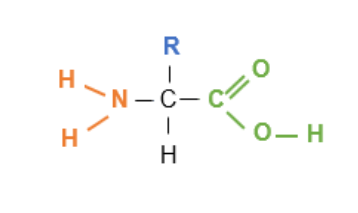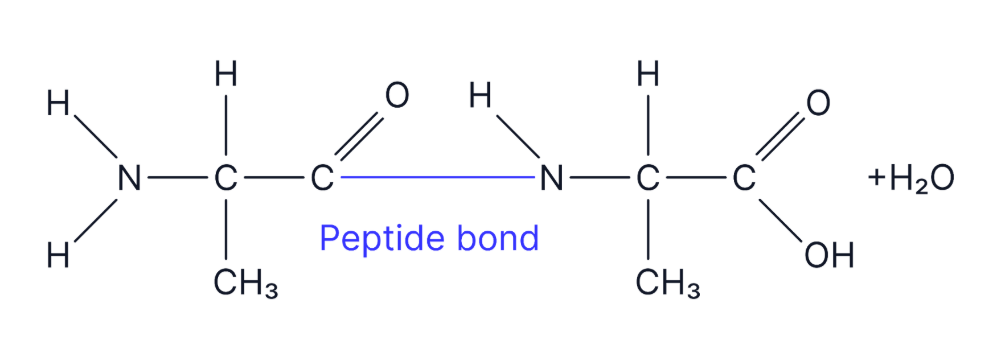proteins and enzymes
1/25
Earn XP
Description and Tags
3.1.4.1- 3.1.4.2
Name | Mastery | Learn | Test | Matching | Spaced |
|---|
No study sessions yet.
26 Terms
draw the structure of amino acids

which elemts make up amino acids and amino acids are the monomers of ******
Proteins are made from amino acids with the elements carbon, hydrogen, oxygen, nitrogen and sulphur (note - only two amino acids contain sulphur).
amino acids are the monomers of proteins
what is made when two amino acids join? what is made when more than two amino acids? Proteins are made of how many polypeptides?
a dipeptide is formed when two amino acids join (via condensation)
a polypeptide is formed when more than two amino acids join together (via condensation)
proteins are made up of one or more polypeptides
name what groups and atoms that make up an amino acid
carboxyl group (-COOH)
hydrogen atom
amine group (-NH2)
an R group (also known as variable side group)
how many amino acids do organisms have? how do these amino acids differ (two points)
20 amino acids
they differ in what makes up their R group
Some are polar (hydrophilic), others are non-polar (hydrophobic).
what kind of reaction occursbetween two amino acids to form a ***** bond
condensation reaction to make polypeptides/ dipeptides. PEPTIDE BOND. A molecule of water is released.
The reverse occurs in digestion - hydrolysis
define polypeptide and how are they formed
long chain of amino acids.
formed by the condensation of many amino acids (usually hundereds)
where does the peptide bond form? what type fo bonding is the bond? draw a diagram
The peptide bond forms between the carboxyl group of one amino acid and the amine group of the next. This is a strong, covalent bond.


This is the amino acid alanine. Draw a diagram of the dipeptide formed when two molecules of alanine are joined together. Label the bond and show anything else that is produced in this reaction (3 marks)

define protein
Protein: A macromolecule composed of amino acids that performs various biological functions
they are a large complex molecule composed of several different polypeptides
how many levels of protein structure are there
4
describe the role of hydrogen bonds in protein structure
hydrogen bonds form between amino acids in the chain and cause the chain to coil into alpha helix or fold into a beta pleated sheet- this is the secondary structure
describe the role of ionic bonds in protein structure. what is their strength and how are they broken
ionic bonds form between any carboxyl and amino acid groups that arn’t involved in forming peptide bonds. Or in other words, the attraction between negative and positive charges on different parts of the molecule) Ionic bonds are weaker than disulphide bridges and broken by changes in ph
how many types of bonding hold the tertiary structure
3- hydrogen ionic and disulphide bridges
describe the role of disulphide bridges
fairly strong bonds that form whenever two molecules of the amino acid cystine come close together- the sulfur atom in one cystine bonds to the sulfur atom in the other.
name some key roles of proteins in organisms
Enzymes (e.g., catalase)
Structural components (e.g., collagen)
Transport molecules (e.g., haemoglobin)
Signalling molecules (e.g., insulin)
Hormones - Some of these are proteins that act as chemical messengers in the body.
Muscle contraction - Muscles are made up of proteins.
Antibodies - These proteins are involved in the immune response
when do you call a polypeptide a protein?
once the polypeptide folds into it’s correct shape for it’s function, then you can call it a protein
define the primary structure of a protein
the specific order of amino acids in a polypeptide chain. the amino acids are held together by peptide bonds (C-N)
why is the primary stucture of the protein really important
because it helps to determine the final 3D shape of the protein molecule. Even one change in one amino acid in primary stucture can alter the final shape of the protein- whic can prevent the protien from carrying out it’s function effectively
which groups have a small negative charge and which have a small postive charge. This attraction causes the formation of what type of bond
the N-H gorups have a small positive charge
the C-_O groups have a small negative charge
the attraction forms hydrogen bonds between the groups all along the polypeptide chain
what is the secondary strcture
hydrogen bonds between N-H groups (slightly postive) and C-_O groups (slightly negative) cause the polypeptide chain to twist and fold into the secondary structure.
what two types of shape can the polypeptide chain adopt in secondary structure from hydrogen bonding
alpha helix or beta pleated sheets
what type of bonds hold the secondary structure in place
hydrogen bonds